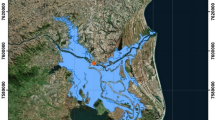Abstract
The Ghis-Nekkor plain, located in the north of Morocco, is a vulnerable area for climate changes due to its influence by the Mediterranean front and due to its strong urbanization. Therefore, a study of the climate evolution changes of the cited plain is essential for conducting climate change impact studies. However, the various studies of future projections, including those of the Intergovernmental Panel on Climate Change (IPCC), are based mainly on outputs of low-resolution climate models that do not allow to approach the regional and local scales. Hence, the objective of this work is to use the outputs of the Operational Regional Climate Models of the Cordex-Africa Project to evaluate future climate change in the Ghis-Nekkor plain. On the first hand, a comparison between the Regional Climate Models (RCMs) using Taylor’s diagram method was performed, then the best models HIRHAM5 for precipitation and RACMO22T for temperature, which performed well in the study area, were retained. The main results from the projections for 2050 CE show a downward trend for precipitation about 18% and an increase in the average temperature of 0.5 °C under the Representative Concentration Pathway 4.5 (RCP 4.5). These predicted parameters were subsequently exploited to study the future climate change by using the De Martonne aridity index (AI) and the standardized precipitation index (SPI). The latter predicts an increasingly dry climate for the Ghis-Nekkor area; it will be more prone to both moderate and severe droughts but less prone to extreme drought by 2070 CE. Moreover, the results also show a change of climate regime becoming arid at the level of the plain (AI = 9.92 mm/°C) by 2080 CE. Finally, a comparison between the two indices (SPI and AI) was carried out, revealing a statistically significant correlation between them for both the observation (1982–2012) and future (2021–2050) periods. The first application of the obtained results is exploited to estimate quantitatively the future groundwater recharge variation in time for the site study under RCP 4.5 and RCP 8.5 scenarios. The results show that for both scenarios, a reduction of the groundwater recharge would be expected around 40% for the period 2020–2080, as the climate regime would be also arid by 2080 CE.













Similar content being viewed by others
References
Bedia J (2012) R practice using data from the ENSEMBLES project. Universidad De Cantabria, Cantabria
Benkaddour K, Lakbir M (1997) Etude hydrogéologique de la nappe du Ghis-Nekkor. Projet de fin d’études. Université Mohammed V, Rabat
Cherkaoui A (2011) Désagrégation des données via l’outil SDSM pour la projection des changements climatiques futurs dans la haute Moulouya, Maroc. Projet de fin d’études. Université Hassan II Mohammedia, Casablanca
De Martonne E (1926) Aréisme et indice d’aridité. Comptes Rendus Académie des Sciences 181:1395–1398
Giorgi F (2006) Climate change hotspots. Geophys Res Lett 33:L08707. https://doi.org/10.1029/2006GL025734
Goury M, Chelhaoui Y (2013) Evaluation comparative des modèles météorologiques entre une région de plaine et une région de montagne et évaluation des scénarios des changements climatiques à l’échelle locale en perspective d’adaptation des projets en développement. Université Mohammed V, Rabat
Iouzzi N (2008) Hydrogéologie et modélisation de la nappe de Ghis-Nekkor (Provinces d’El Hoceima-Nador), DESS. Université Mohammed V, Rabat
IPCC (2007) Working group II contribution to the forth assessment report of the intergovernmental panel on climate change
IPCC (2013) The intergovernmental panel on climate change fifth assessment report (AR5)
Jounaid H (2002) Hydrogéologie de la nappe de Ghis-Nekkor, thèse de Doctorat en sciences appliquées. Université Mohammed V, Rabat
Loukas A, Vasiliades L (2004) Probabilistic analysis of drought spatiotemporal characteristics in Thessaly region, Greece. Nat Hazards Earth Syst Sci 4:719–731
Markos A (2015) Drought in Greece under future climates, master thesis, University of Joseph Fourier, Grenoble I
Mazena O, Renata J, Lawrence D, Wong W (2016) Trends in projections of standardized precipitation indices in a future climate in Poland. Hydrol Earth Syst Sci 20:1947–1969
McKee T. B, Doesken N. J (1993) The relationship of drought frequency and duration of timescales. Climatology Report No.97-2, Colorado State Univ., Ft. Collins, COOrganisation Météorologique Mondiale Temps-Climat-Eau (2012) Guide d’utilisation de l’indice de précipitations normalisé, Report : OMM-No. 1090, pp 5–13
Ressources en eau du Maroc Tome 1 (1971) Domaines du Rif et du Maroc Oriental, pp 69–79
Salhi A, Benabdelouahab S (2017) Etude hydrogéologique de la nappe alluviale de Ghis-Nekkor (Maroc), 116–118. Doctorat, Université Abdel Malek Essaidi, Tetouan. Maroc
Samuelsson P (2006) Projection results from the Cordex Africa domain. Rosby Center, SMHI, Brooklyn
Sayari N, Bannayan M, Alizadeh A (2012) Using drought indices to assess climate change impacts on drought conditions in the northeast of Iran (case study: Kashafrood basin). Meteorol Appl 20:115–127
SRES (2000) Special Report Emissions Scenarios, summary for policymakers
Taylor KE (2001) Summarizing multiple aspects of model performance in a single diagram. J Geophys Res 106:7183–7192
Acknowledgements
This research is a part of the Ph.D. thesis of the first author at the Mohammadia School of Engineers, Mohammed V University in Rabat. The authors would like to thank the Moroccan Ministry of Water for providing data to perform this research.
Funding
This research is a part of the MEDAQCLIM research project funded by the ERANET-MED EU FP7 program.
Author information
Authors and Affiliations
Corresponding author
Additional information
Publisher’s note
Springer Nature remains neutral with regard to jurisdictional claims in published maps and institutional affiliations.
Rights and permissions
About this article
Cite this article
El Asri, H., Larabi, A. & Faouzi, M. Climate change projections in the Ghis-Nekkor region of Morocco and potential impact on groundwater recharge. Theor Appl Climatol 138, 713–727 (2019). https://doi.org/10.1007/s00704-019-02834-8
Received:
Accepted:
Published:
Issue Date:
DOI: https://doi.org/10.1007/s00704-019-02834-8




